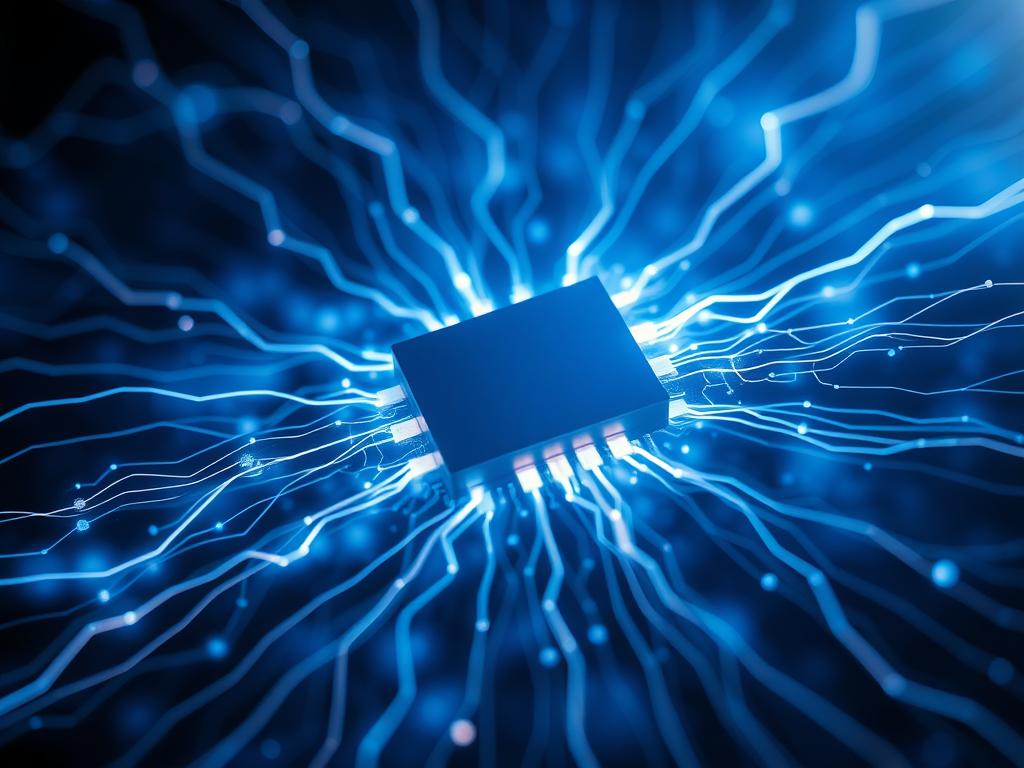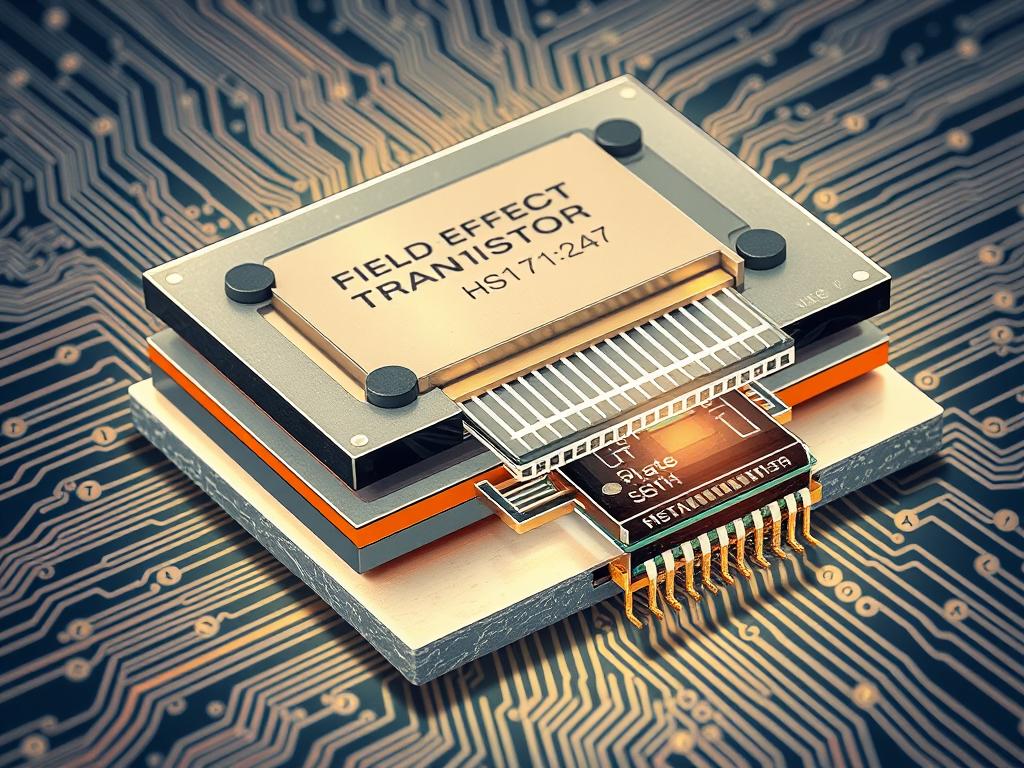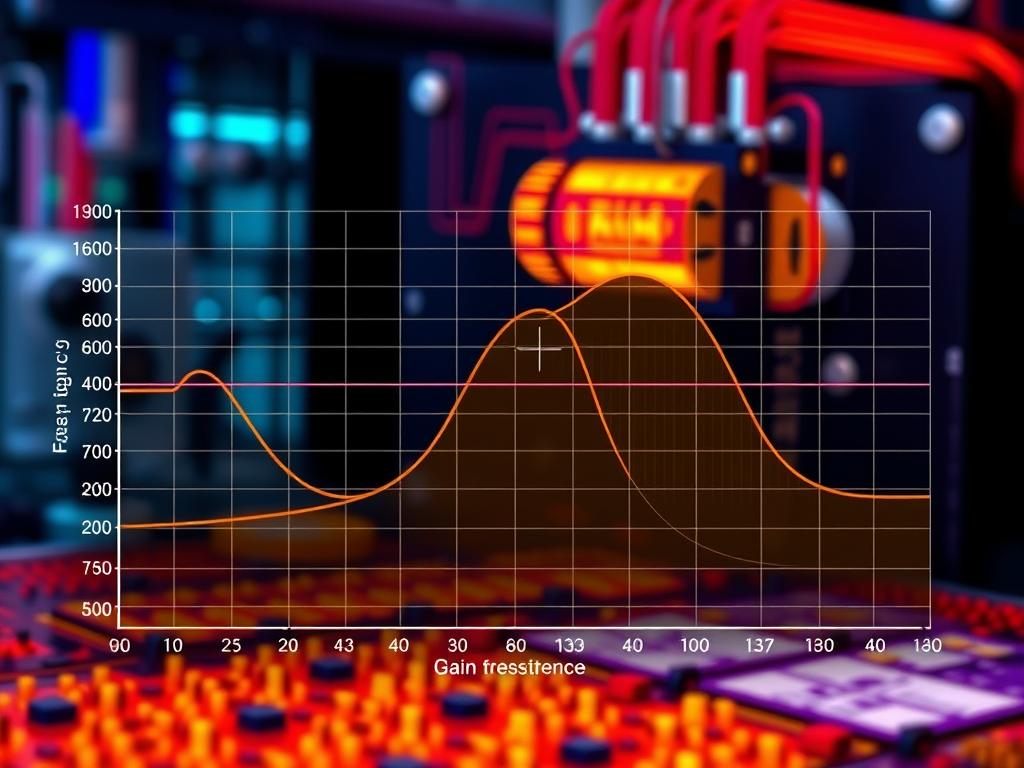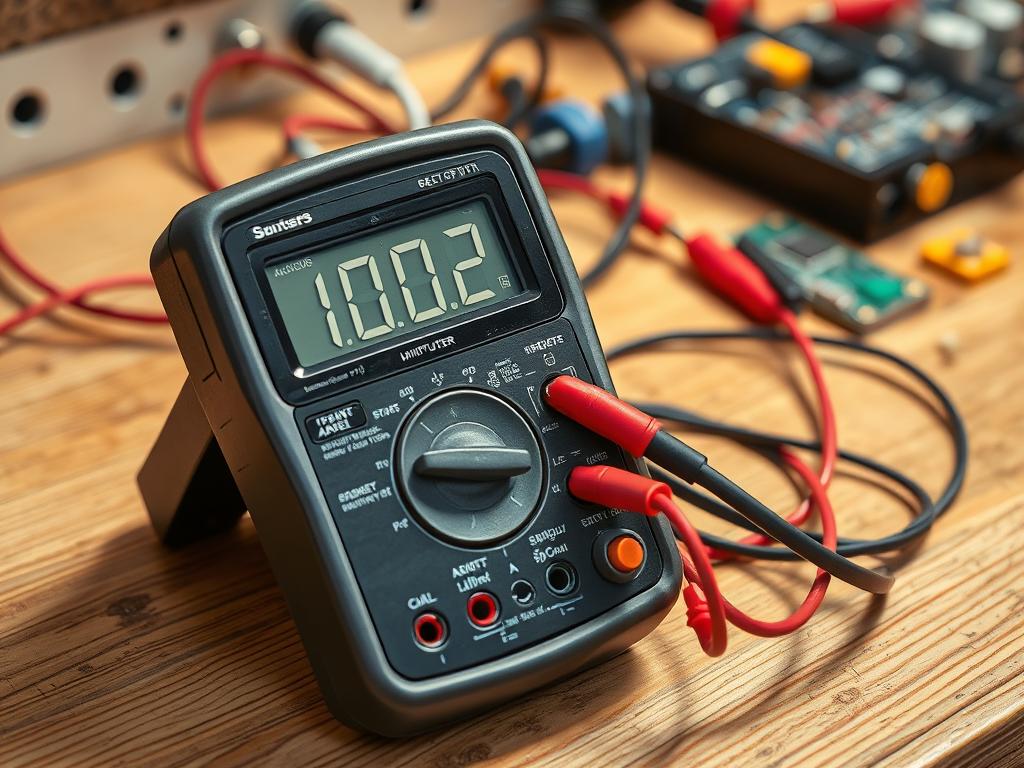Field-effect transistors (FETs) are key in today’s electronics. They power many things, from phones to computers. These devices use an electric field to control current flow. Knowing the terms and definitions of FETs is important for anyone interested in electronics.
Field-effect transistors come in types like MOSFETs and JFETs. Each type is suited for different uses. They work by applying a voltage to the gate, which affects the channel’s conductivity.
Key Takeaways
- FETs are fundamental semiconductor devices that control the flow of electrical current using an electric field.
- FETs are classified into various types, such as MOSFETs and JFETs, each with unique characteristics and applications.
- Understanding the key terminology and definitions associated with FETs is crucial for electronics professionals and enthusiasts.
- FETs exhibit high input impedance, making them ideal for sensor applications where minimal loading is crucial.
- FETs in terahertz detectors can enhance signal amplification and processing efficiency through integrated circuits.
Introduction to Field-Effect Transistors
Field-effect transistors (FETs) are key in today’s electronics. They act as both amplifiers and switches. This lets them handle and control electronic signals well.
They work with high input impedance and use less power. This makes them very useful in many fields. They help in detecting terahertz signals and powering advanced circuits.
What is a Field-Effect Transistor?
A field-effect transistor is a three-terminal device. It controls electric current in a semiconductor material with an electric field. The terminals are the gate, drain, and source.
By applying a voltage to the gate, the FET can change the channel’s conductivity. This lets it act as an amplifier or a switch.
Importance of FETs in Electronics
FETs are crucial in today’s electronic devices and circuits. They have high input impedance and use less power. This makes them perfect for many uses, like amplifiers and switches.
They are often chosen over bipolar junction transistors (BJTs) because of their better characteristics. FETs help make devices smaller and better. This has led to the creation of advanced tech like smartphones and laptops.
“The low power consumption and low power dissipation of FET transistors make them ideal for integrated circuits.”
| Characteristic | FET Advantage |
|---|---|
| Threshold Voltage | FETs generally have a lower threshold voltage, allowing for more efficient operation and lower power consumption. |
| Transconductance | FETs exhibit higher transconductance, enabling greater amplification and control of electronic signals. |
| Input Impedance | FETs have a remarkably high input impedance, making them suitable for applications that require minimal loading on the input circuit. |
| Power Consumption | FETs consume significantly less power compared to their bipolar counterparts, contributing to the efficiency and extended battery life of electronic devices. |
FETs are vital in today’s electronics. They power many devices and help technology keep advancing.
Basic Principles of FET Operation
Field-Effect Transistors (FETs) work by using an electric field to control charge carriers in a semiconductor. This makes them great switches and amplifiers in many electronic circuits and devices.
How FETs Work
An FET has a semiconductor channel, usually silicon or gallium arsenide, between the source and drain. The channel’s conductivity is controlled by an electric field. This field is created by a voltage on the gate terminal, which is isolated from the channel.
Applying a voltage to the gate creates an electric field that can either increase or decrease charge carriers in the channel. By adjusting the gate voltage, the FET can act like a variable resistor. This lets FETs switch or amplify signals in circuits.
Understanding Gate Voltage
The gate voltage is key to an FET’s operation. It can either boost or reduce the charge carriers in the channel:
- In Enhancement-mode FETs, a positive gate voltage increases conductivity, letting more current flow.
- Depletion-mode FETs use a negative gate voltage to lower conductivity, reducing current.
By controlling the gate voltage, FETs can amplify signals or act as switches. They are vital in many electronic circuits and devices.

“The operation of FETs relies on the creation of an electric field, which influences the conductivity of a channel between the source and drain terminals. The gate voltage controls this electric field, modulating the channel’s conductivity.”
Types of Field-Effect Transistors
Field-Effect Transistors (FETs) come in different types, each with its own features and uses. The Junction Field-Effect Transistor (JFET) and the Metal-Oxide-Semiconductor Field-Effect Transistor (MOSFET) are two well-known types.
Junction Field-Effect Transistor (JFET)
The JFET works by controlling current with an electric field. It has p-type regions diffused into an n-type semiconductor. This creates a p-n junction that acts as a variable resistance controlled by voltage.
In a JFET, the current changes linearly with voltage until it hits saturation. Its high input resistance makes it great for analog circuits needing high-impedance inputs.
Metal-Oxide-Semiconductor FET (MOSFET)
The MOSFET uses a different method to control current than the JFET. It has an insulating oxide layer and a silicon nitride layer to protect the oxide. A positive gate potential creates a negative charge, allowing current to be controlled by the gate voltage.
The MOSFET’s high input resistance, about 1014 ohms, is a big plus. This makes it perfect for digital circuits needing high-impedance inputs. MOSFETs can be either enhancement-type or depletion-type, each with its own operating style.
| Comparison | JFET | MOSFET |
|---|---|---|
| Control Mechanism | Current controlled by electric field | Voltage-controlled variable resistance |
| Input Resistance | Relatively high | Exceptionally high (1014 ohms) |
| Applications | Analog circuits | Digital circuits |
| Variants | N-channel, P-channel | Enhancement-type, Depletion-type |
There are more FET types like IGFET (Insulated-Gate FET) and MESFET (Metal-Semiconductor FET). Each has its own special features and uses in electronics.
Key Components of FETs
Field-effect transistors (FETs) are complex devices made of several key parts. These parts work together to make FETs special. Knowing how these parts interact helps us understand how FETs work and their uses.
Gate, Drain, and Source Terminology
The main parts of a FET are the gate, drain, and source. The gate controls the electric field inside the device. It decides how charge carriers move between the source and drain.
The source and drain let current flow through the channel when the device is on.
Role of the Substrate
The substrate is the base of the FET. It supports the structure and holds the layers together. The substrate, usually silicon, is key for the FET’s work. It affects the device’s electrical traits and performance.
| FET Component | Function |
|---|---|
| Gate | Controls the electric field and regulates current flow |
| Source | Allows current to flow through the semiconductor channel |
| Drain | Allows current to flow through the semiconductor channel |
| Substrate | Provides structural support and platform for the semiconductor layers |
Understanding FET components and their roles helps electronics experts. They can then use FETs in many electronic fields.

FET Characteristics and Parameters
Field-Effect Transistors (FETs) have key parameters that show how well they work in circuits. Important FET traits include transconductance, drain current, threshold voltage, and how they output. Knowing these is key to making FETs work better and reliably.
Transconductance and Drain Current
Transconductance shows how the gate voltage affects the drain current. It’s vital for making amplifiers work well. The drain current is the most current an FET can handle when fully on, at 25°C.
Threshold Voltage Explained
The threshold voltage, VGS(TH), is the lowest gate-to-source voltage needed for a channel. It’s crucial for knowing when the FET turns on and off. The threshold voltage also changes with temperature, affecting how fast the FET turns on and off.
Output Characteristics Curve
The output characteristics curve shows how the drain current (ID) and drain-to-source voltage (VDS) relate at a fixed gate-to-source voltage (VGS). This curve helps understand the FET’s behavior in different states. It’s also useful for seeing how the FET handles input impedance and power consumption.
“The output characteristics of a FET are a valuable tool for understanding its behavior and optimizing its performance in various applications.”
Applications of Field-Effect Transistors
Field-Effect Transistors (FETs) are key in electronics, especially in amplifiers and switches. They are great for sensor uses where they don’t mess up the signal. In terahertz tech, FETs help improve signal handling and processing.
FETs in Amplifiers
Junction Field-Effect Transistors (JFETs) are good for amplifying signals. They work well in audio gear and for matching impedance. Their low noise is perfect for sensitive tasks.
Role in Switching Applications
FETs are great as analog switches. They handle resistance well, making them useful in voltage-controlled circuits. They also work well in high-frequency circuits, important for digital and radio tech.
In sensors, FETs are key for handling terahertz signals. They help amplify and process signals, crucial for accurate measurements. This is especially true in terahertz signals and sensor applications, where they reduce interference and boost performance.
| Application | Benefit of FETs |
|---|---|
| Amplifiers | High input impedance, low output impedance, low noise |
| Switching Circuits | Low on-resistance, high off-resistance, voltage-controlled resistance |
| Terahertz Signal Processing | Efficient signal amplification and processing, minimized interference |
| Sensor Applications | Minimal loading on previous stage, enhanced measurement accuracy |
FETs are versatile, used in many areas like amplifiers, switches, and terahertz tech. Their high input impedance, low noise, and ability to handle high frequencies make them essential in today’s electronics.

Advantages of Field-Effect Transistors
Field-effect transistors (FETs) have many benefits that make them popular in electronics. They have high input impedance, are thermally stable, and are more efficient and quieter than bipolar junction transistors (BJTs).
High Input Impedance Benefits
FETs have high input impedance. This means they can connect to signal sources without affecting them. This is very important in sensor applications, where keeping the signal clean is key.
Thermal Stability Features
FETs also stay stable in different temperatures. This is crucial for reliable circuit performance, even when temperatures change. Their stability is essential in many applications.
Also, FETs use less power and make less noise than BJTs. This makes them great for power-efficient and quiet applications. They’re perfect for sensitive detection and high-frequency circuits.
With their high input impedance, thermal stability, and better power efficiency and noise reduction, FETs are a top choice. They’re used in many devices, from amplifiers to sensors.
Limitations of Field-Effect Transistors
Field-effect transistors (FETs) are great for electronic circuits but have some downsides. Engineers need to think about these when making high-performance systems. The main issues are how FETs handle high frequencies and their power use.
Frequency Response Constraints
In high-frequency work, FETs can struggle. This is because of their parasitic capacitances. These capacitances act like filters, limiting how fast the FET can work. To improve this, designers must tweak the FET’s design and layout.
Power Dissipation Issues
Using FETs in high-power situations can lead to heat problems. The heat comes from the voltage and current the FET handles. To keep the FET cool, engineers use heat sinks or active cooling systems.
Knowing the limits of FETs is key for making efficient circuits. By tackling these issues, engineers can make the most of FETs in many applications. This includes both high-frequency and high-power systems.

“Careful consideration of FET limitations is essential for optimizing circuit performance and ensuring long-term reliability.”
Comparison: FETs vs. Bipolar Junction Transistors
Field-Effect Transistors (FETs) and Bipolar Junction Transistors (BJTs) are two main types of semiconductor devices. Each has its own special features and uses. Knowing the main differences between these two is key for anyone working with electronics.
Key Differences Between FETs and BJTs
FETs work by controlling voltage, while BJTs control current. This is the main difference between them.
FETs also have a high input impedance, which is millions of ohms (MΩ). BJTs have a lower input impedance, around thousands of ohms (kΩ). This makes FETs better for high-impedance applications like amplifiers.
When to Use FETs Over BJTs
FETs have some big advantages over BJTs:
- They use less power and stay stable in temperature, making them great for small, portable devices.
- Their high input impedance means they don’t affect the circuits before them much, perfect for high-gain amplifiers.
- FETs work well in different temperatures, offering consistent and reliable performance.
- They are simpler to make into Integrated Circuits (ICs), allowing for smaller and more complex devices.
But BJTs might be better for some jobs, like handling high currents or working at high frequencies.
| Parameter | FET | BJT |
|---|---|---|
| Control Mechanism | Voltage-controlled | Current-controlled |
| Input Impedance | High (MΩ range) | Low (kΩ range) |
| Thermal Stability | Good | Fair |
| Power Consumption | Low | High |
| Switching Speed | Fast | Moderate |
| Cost | Higher | Lower |
Understanding the differences between FETs and BJTs helps electronics experts choose the right transistor for their projects. Whether it’s for voltage-controlled devices or current-controlled devices, knowing the options is key.
FET Circuit Configurations
Field-Effect Transistors (FETs) come in different circuit setups, each with its own special traits and uses. The main types are the common source, common drain, and cascaded FET setups. Knowing these is key for making top-notch amplifier circuits and signal processing systems.
Common Source Configuration
The common source setup is the most common among FET circuits. It has the source terminal shared by both the input and output circuits. The gate and drain handle the input and output, respectively. This setup is great for boosting voltage, offering a high voltage gain.
Common Drain Configuration
The common drain setup, also known as the source follower, has high input and low output impedance. It’s often used as a buffer to match impedances and isolate stages. It’s like the transistor common emitter amplifier but with input and output swapped.
Cascaded FET Configurations
Cascaded FET setups link several FET stages together. This setup can achieve higher gain and better frequency response than single-stage FETs. It’s perfect for building high-performance amplifier circuits and signal processing systems.
| Configuration | Voltage Gain | Current Gain | Power Gain | Input Resistance | Output Resistance | Input/Output Phase |
|---|---|---|---|---|---|---|
| Common Source | High | Low | Moderate | High | Moderate | 180° |
| Common Drain | Less than 1 | High | Moderate | High | Low | 0° |
| Common Gate | Moderate | Moderate | Low | Low | High | 0° |
By grasping these FET circuit setups, electronics experts can craft and refine a broad spectrum of amplifier circuits and signal processing projects. They can tap into the unique advantages and features of Field-Effect Transistors.
FET Biasing Techniques
Proper biasing is key for field-effect transistors (FETs) to work their best. Finding the right DC operating point is vital for FETs in amplifiers and switches. There are three main ways to bias FETs: self-bias, voltage divider bias, and source bias.
Importance of Proper Biasing
Good biasing makes sure FETs run in the right part of their curve. This gives them stability and helps with temperature changes. For FET circuits, it’s especially important because these devices can change a lot in their behavior.
Methods for Biasing FETs
- Self-bias: This is the most common method for junction FETs (JFETs). It makes sure the gate-source voltage (VGS) is zero. The drain current (ID) then depends on the source resistance (RS).
- Voltage Divider Bias: Here, a voltage divider sets the gate-source voltage (VGS) for the right drain current (ID).
- Source Bias: This is like self-bias but with the source connected to ground through a resistor. It keeps the bias stable with temperature changes.
The right biasing method depends on what the circuit needs. It could be stability, temperature control, or keeping things simple. With the right biasing, FET circuits work well in many electronic systems.
“Proper biasing is essential for maximizing the performance of field-effect transistors in amplifier and switching applications.”
The basics of FET biasing are important for understanding these devices. Knowing how to bias FETs helps make circuits that are strong and reliable. This is key for the progress of modern electronics.
Testing Field-Effect Transistors
Testing field-effect transistors (FETs) is key to making sure they work right. We use tools like multimeters and curve tracers for this. It helps find problems early on.
Basic Testing Equipment
Here are the main tools for FET testing:
- Multimeter: Checks for shorts and measures voltage and current.
- Curve Tracer: Shows how the FET performs under different conditions.
Steps for Testing FET Functionality
Here’s how to test a FET:
- Look for any damage or defects.
- Check for shorts with a multimeter.
- Measure the gate-to-source voltage.
- See how the drain current changes with gate voltage.
- Use a curve tracer for detailed performance checks.
By following these steps and using the right tools, we can make sure FETs work well. This helps avoid problems later on.

“Proper testing procedures are crucial for ensuring FET functionality and identifying potential issues before integration into electronic circuits.”
Troubleshooting Common FET Issues
Field-Effect Transistors (FETs) are key in today’s electronics. But, they sometimes face problems that need careful fixing. The two main issues are gate leakage and thermal runaway.
Symptoms of Malfunctioning FETs
FETs can show signs of trouble like unexpected changes in current, too much heat, or even failing completely. Spotting these signs early is key to keeping FETs working well.
Diagnostic Techniques
- Testing FETs’ parameters like gate-source voltage and transconductance can find the problem.
- Thermal imaging helps spot too much heat, which might mean thermal runaway or other heat issues.
- Looking at how the FET acts in the circuit can also help. If it’s not working right, it might be broken.
Using these methods, experts can find and fix common FET problems. This keeps electronic systems running smoothly.
| FET Issue | Symptoms | Diagnostic Techniques |
|---|---|---|
| Gate Leakage |
|
|
| Thermal Runaway |
|
|
Knowing about common FET problems and how to fix them helps experts keep electronic systems working right.
Future Trends in Field-Effect Transistor Technology
The electronics world is always changing, and FET technology is no exception. New materials like graphene and carbon nanotubes are making devices faster and more energy-efficient. These advancements are key for the next big leap in computing and flexible electronics.
Emerging Applications in Technology
FET biosensors made from new materials are super sensitive. They can detect pH changes with high accuracy. These graphene-based sensors are great for medical tests, spotting diseases quickly and accurately.
There’s a new trend in FET biosensors for DNA/RNA detection without amplification. This makes genetic testing faster and more precise. By combining these sensors with CMOS tech, we get devices that can send data in real-time. This is a big step forward for health monitoring and remote diagnostics.
Impact of Miniaturization
Getting smaller is making FETs more efficient and easier to use. New silicon FET designs, like OG-JFET, are being explored for DNA sensing. This could lead to storing DNA data in a way that’s easy to retrieve.
The flexible electronics market is booming, thanks to FET-based sensors and devices. These advancements are opening up new areas for wearables, healthcare, and IoT applications.
The Field Effect Transistor market is set to grow to USD XX Million by 2032. This growth is fueled by the need for better electronics, the rise of flexible electronics, and ongoing FET tech improvements.
| Key Players in FET Market | Market Segmentation | Regional Outlook |
|---|---|---|
| NXP, Fairchild Semiconductors, Wuxi Donghai, IXYS, Farnell, Texas Instruments, Diotec | Product types: JFET and MOS Applications: Electronics and Aerospace | North America, Europe, Asia Pacific, Latin America, Middle East & Africa |
The future of FET technology looks bright. With new materials, smaller designs, and better integration, we’re on the verge of exciting new uses in many fields.
Summary of FET Terminology
Understanding FET terminology is key for working with these electronic devices. FETs include junction FETs (JFETs) and metal-oxide-semiconductor FETs (MOSFETs). They are used in many circuits and systems because of their unique features.
Quick Reference to Key Terms
- Gate: The terminal that controls the flow of current between the source and drain.
- Drain: The terminal that collects the current flowing through the channel.
- Source: The terminal that supplies the current flowing through the channel.
- Channel: The region between the source and drain where current flows.
- Threshold Voltage: The minimum gate-to-source voltage required to turn on the FET and allow current to flow.
- Transconductance: The measure of the change in drain current due to a change in gate-to-source voltage.
These terms explain the main parts and how FETs work. They help us understand their role in electronic circuits and systems.
Importance of Glossaries in Learning
Glossaries are very helpful for those working with FETs. They provide clear definitions of technical terms. This helps in accurate communication and better understanding of FET concepts.
Knowing FET terminology is crucial for designing, troubleshooting, and using these devices in various electronic applications.
| Key Statistic | Value |
|---|---|
| MOSFETs are more common than BJTs in digital and analog circuits | MOSFETs are now more common than BJTs in digital and analog circuits. |
| Number of MOSFETs in a memory chip or microprocessor | Hundreds of thousands or millions of MOSFETs may be included in a memory chip or microprocessor. |
| MOSFET semiconductor types | MOSFETs can be made with either p-type or n-type semiconductors. |
| Input impedance of MOSFETs in amplifiers | MOSFETs offer almost infinite input impedance in amplifiers. |
| Input current requirement for MOSFETs | MOSFETs require almost no input current to control load current. |
| Applications of MOSFETs | MOSFETs are used in amplifiers, DC motor regulation, chopper amplifiers, and switching and amplifying signals. |
These stats show how widely MOSFETs are used. They are the top choice in modern electronics because of their benefits and performance.
“Mastering FET terminology is essential for successful design, troubleshooting, and integration of these devices in a wide range of electronic applications.”
Additional Resources for Learning FETs
Learning about Field-Effect Transistors (FETs) needs a good grasp of technical books and online materials. Whether you’re into electronics, studying engineering, or just curious, there’s a lot to learn. These resources can help you understand FETs better, which are key in today’s electronics.
Recommended Books and Articles
For detailed info on FETs, check out top textbooks and scientific articles. Some great sources include:
- “Semiconductor Devices: Physics and Technology” by S.M. Sze and Kwok K. Ng
- “Microelectronic Circuits” by Adel S. Sedra and Kenneth C. Smith
- IEEE Transactions on Electron Devices and IEEE Electron Device Letters, which have the latest FET tech
Online Courses and Tutorials
The internet also has lots of learning tools for FETs. Sites like Coursera, edX, and MIT OpenCourseWare offer detailed courses. They cover the basics, how they work, and their uses. These courses are great for all levels, helping both newbies and experts learn more about FETs.
By diving into these educational materials and technical literature, you can really get into FETs. This will help you understand their design and use better. It’s a great way to grow your knowledge in the exciting world of electronics.
Conclusion: Mastering FET Terminology
Learning about Field-Effect Transistors (FETs) is key for those in electronic engineering. Knowing FET concepts helps in designing, fixing, and creating new electronic systems. With new tech coming out fast, it’s important to keep learning about FETs.
Importance of Understanding FET Concepts
People in the electronics world need to keep up with new research and trends. Knowing FET terms like gate voltage and drain current helps understand circuits better. It also improves problem-solving skills.
Encouragement to Explore Further
There are many resources out there, like Texas Instruments’ glossary, tutorials, and online courses. These offer chances to keep learning and growing in electronic engineering expertise. By using these resources, you can learn more about FETs and stay ahead in this fast-changing field.


